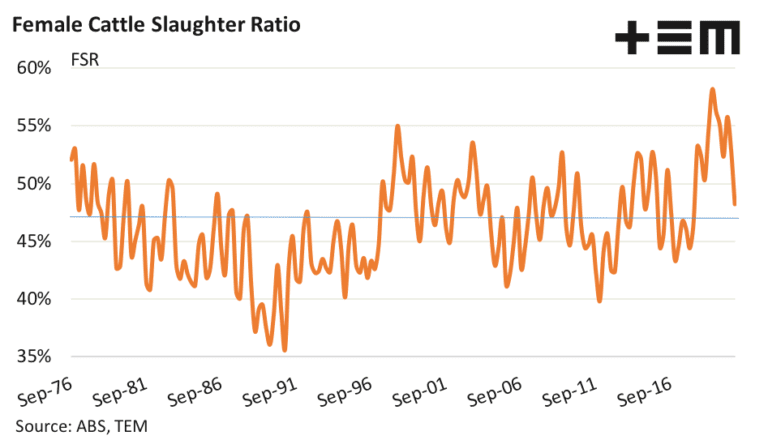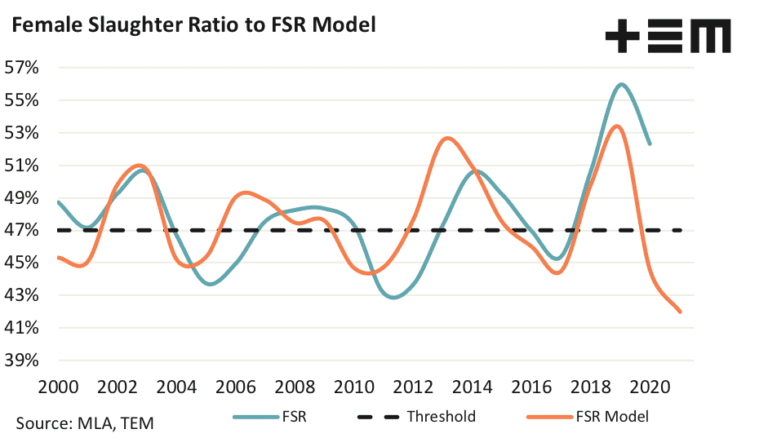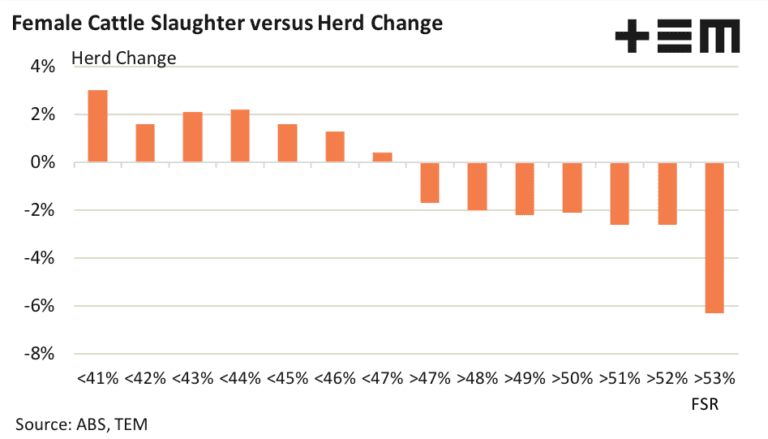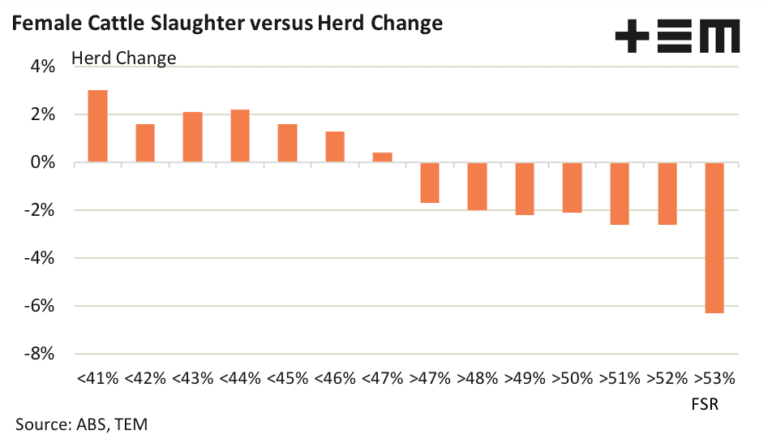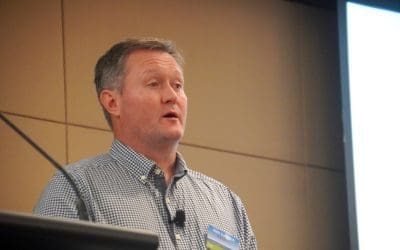 In this article, Thomas Elder Markets’ Matt Dalgleish looks for evidence of green sprouts in the national beef herd rebuild, using female slaughter numbers for guidance…
In this article, Thomas Elder Markets’ Matt Dalgleish looks for evidence of green sprouts in the national beef herd rebuild, using female slaughter numbers for guidance…
THE shift to quarterly slaughter reporting by the Australian Bureau of Statistics means that the industry will have to wait until May before it can be seen if the herd is in a technical rebuild, with the Female Slaughter Ratio (FSR) below 47 percent.
However, using saleyard spread data on restocker behaviour and the historic comparative price performance of breeding stock, we can generate a predictive model of where the FSR currently sits.
The FSR finished the 2020 season at 52.3pc on an annual average basis (read more on this below). The graph plot below shows the annual average FSR compared to the FSR predictive model. Based on the market spread inputs to the model for the first quarter of 2021 the predictive model suggests that the Australian herd is now in a rebuild phase, with the FSR model placing it near 42pc.
Interestingly, looking at the FSR model to the actual FSR trend it appears that the model is a good lead indicator for where the FSR is heading, as there are times when the model pre-empts the actual figure by 3-6 months. This could suggest that we may not see an FSR as low as 42pc during the first quarter of 2021 but perhaps into the second or third quarter.
Nevertheless, an FSR in the low 40pc region often results in annual herd increases between 2pc and 3pc, which is consistent with Meat & Livestock Australia’s recent 2021 Cattle Industry Projections report, which anticipates the Australian herd to grow by 2pc this year to reach 25.2 million head.
Rebuilding happening at snail’s pace
Australian Bureau of Statistics (ABS) quarterly cattle slaughter data to the end of 2020 was released yesterday, and it is the first opportunity to see if the herd is in a technical rebuild yet. The threshold to denote rebuild or liquidation is a female slaughter ratio (FSR) of 47pc.
Analysis of the annual average FSR to the annual herd change shows a clear relationship between rebuild when the FSR is under 47pc and liquidation when it is above 47pc. On a quarterly basis the FSR came in at 48.2pc for the fourth quarter of 2020, down from 53pc in quarter three.
The reduction in females as a proportion of total slaughter highlighted by the easing of the FSR indicated that producers are heading in the right direction for a rebuild, but weren’t quite there as of the end of 2020. The annual average FSR for 2020 came in at 52.3pc, down from a record annual average of 56pc in 2019.
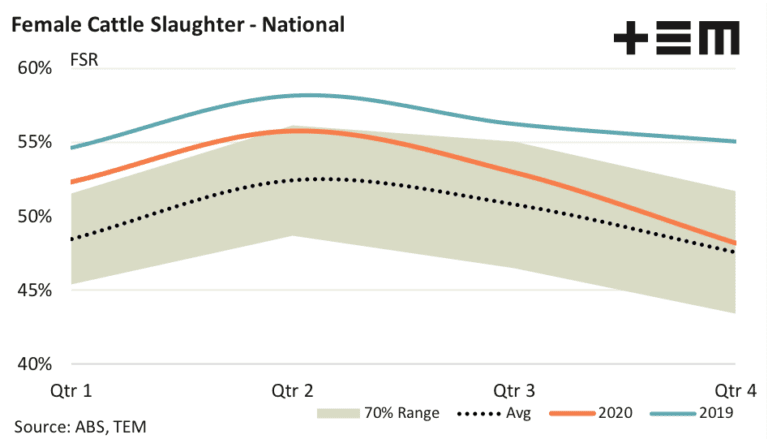
Pleasingly, all of the mainland east coast states have begun to head in the right direction for a rebuild to begin during 2021. Queensland has seen its FSR drop from 45.5pc to 40.4pc over the final quarter or 2020, to record an annual average FSR of 45.1pc for the year.
The fourth quarter FSR in NSW dipped from 53.6pc to 48.2pc, bringing the annual average FSR there to 51.6pc. Meanwhile, the Victorian FSR fell from 68.4pc to 62.6pc, which puts their FSR at 66.3pc on an annual average basis.
Bear in mind that the threshold FSR to denote rebuild/liquidation is different in each state, as their reproduction success and calf branding rates vary. Generally speaking, Queensland needs to hold a higher proportion of females in their herd than the southern states so their threshold between rebuild to de-stocking is closer to 40pc. The higher proportion of dairy cull cows in Victoria also means their FSR remains at a higher ratio.
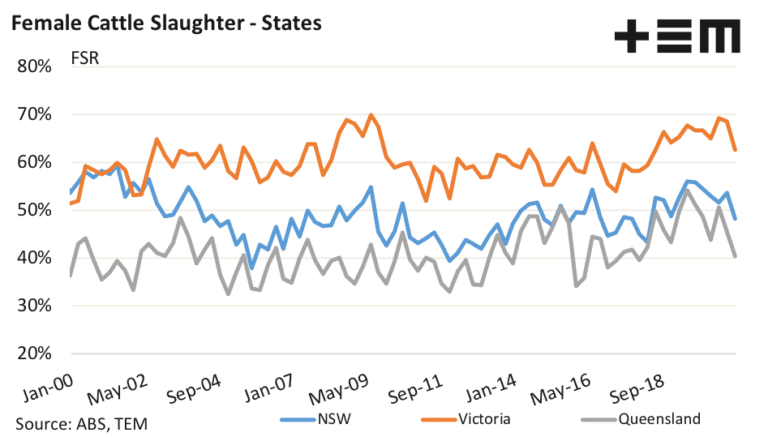
Analysis of restocker behaviour and the historic correlation between breeding cattle spreads to the FSR suggests that the quarter one 2021 FSR will come in below 47pc, possibly toward the 42-44pc range.
Unfortunately, with the lagged ABS data we will not know for sure until the middle of May. (click here for a short update on the FSR predictive model)
The slow pace of the rebuild is somewhat concerning, given the very good seasonal conditions across much of the eastern seaboard it would be expected that producers are keen to hold breeding stock and rebuild at a quicker pace. The very strong prices on offer for cattle must be tempting some to continue offering females for turnoff.
The very wet seasons associated with a La Nina across parts of the eastern states often doesn’t last for more than a couple of years. We are already one year into the current La Nina and the Bureau of Meteorology has suggested recently that the impact of La Nina could already be on the wane. Analysis of 120 years of rainfall data suggests that after a very wet few seasons we are usually back in drought within 2-4 years.
It doesn’t leave much time left to get the Australian herd back nearer to 28-30 million head.
